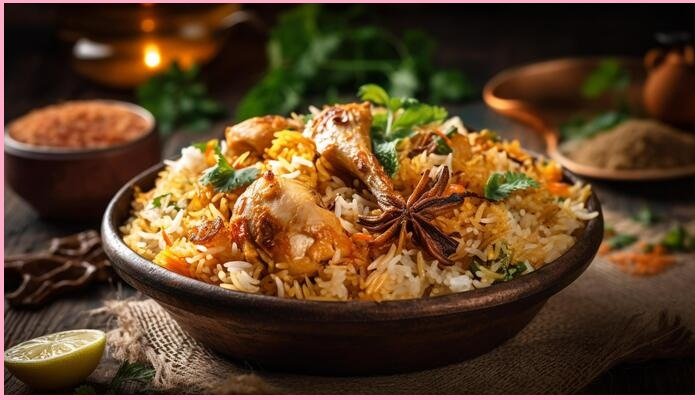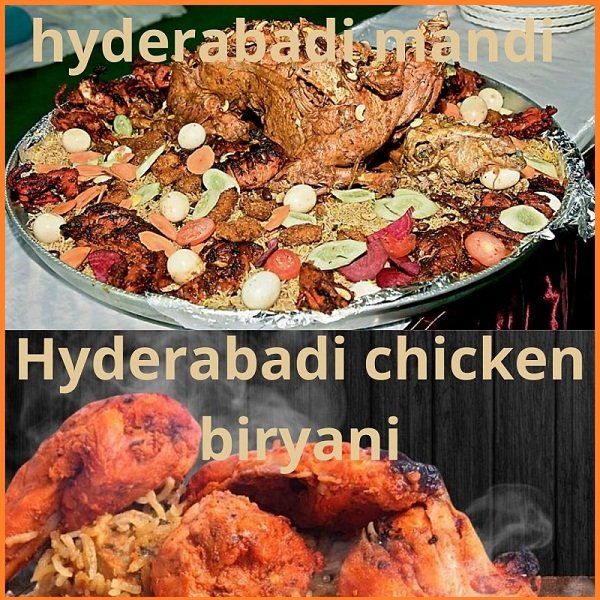
What is the Difference Between Hyderabadi Biryani vs Mandi
Hyderabadi cuisine is renowned for its rich flavors, aromatic spices, and diverse dishes. Among the many culinary delights, Hyderabadi Biryani and Hyderabadi Mandi stand out as two of the most beloved dishes. While both are rice-based dishes, they are distinct in their preparation, ingredients, and taste. This blog post will delve into the key differences between Hyderabadi Biryani and Hyderabadi Mandi, highlighting their unique characteristics and cultural significance.
Introduction to Hyderabadi Biryani
Hyderabadi Biryani is a legendary dish that has won hearts worldwide. Originating from the kitchens of the Nizams of Hyderabad, this dish is a perfect blend of Mughlai and Telugu cuisines. It is known for its aromatic basmati rice, tender meat, and a rich blend of spices.
Key Ingredients:
Basmati rice
Meat (usually chicken, mutton, or beef)
Yogurt
Fried onions
Saffron
Spices (cumin, coriander, cardamom, cloves, cinnamon, bay leaves, and more)
Cooking Technique:
Hyderabadi Biryani is traditionally cooked using the dum method, where the meat and rice are layered and slow-cooked in a sealed pot. This method allows the flavors to meld together, creating a dish that is both aromatic and flavorful. The use of saffron and fried onions adds a distinctive richness and color to the dish.
Flavor Profile:
The flavor of Hyderabadi Biryani is a harmonious blend of spices and meat juices. The rice absorbs the flavors of the meat and spices, resulting in a dish that is savory, aromatic, and slightly spicy. The addition of yogurt adds a subtle tanginess that balances the spices.
Introduction to Hyderabadi Mandi
Hyderabadi Mandi, on the other hand, is a relatively newer addition to the city’s culinary scene but has quickly gained popularity. Mandi has its roots in Yemen and has been adapted to suit the Indian palate. It is known for its distinct preparation method and unique flavor profile.
Key Ingredients:
Basmati or Sela rice
Meat (usually chicken or mutton)
Spices (less intense compared to Biryani; includes cardamom, cloves, cinnamon, and bay leaves)
Dried lime (loomi)
Nuts and raisins (optional)
Ghee
Cooking Technique:
Mandi is traditionally cooked in a tandoor or a specially designed pit. The meat is first marinated and then slow-cooked over a wood fire, which imparts a smoky flavor to the dish. The rice is cooked separately and mixed with the meat just before serving. This method ensures that the meat remains juicy and tender while the rice is flavorful yet not overly spicy.
Flavor Profile:
Hyderabadi Mandi has a milder flavor compared to Biryani. The use of dried lime adds a unique tanginess, while the slow-cooking method gives the meat a tender, smoky flavor. The spices are more subtle, allowing the natural flavors of the meat to shine through. The addition of nuts and raisins provides a hint of sweetness that complements the dish.

Comparison of Ingredients
While both dishes use rice and meat as their main ingredients, the choice of spices and additional components varies significantly. Hyderabadi Biryani relies on a rich blend of spices, yogurt, and saffron to create its signature taste, while Mandi uses fewer spices, dried lime, and sometimes nuts and raisins for a more subtle flavor profile.
Comparison of Cooking Techniques
The cooking techniques for Hyderabadi Biryani and Mandi are also quite different. Biryani is cooked using the dum method, which involves layering the meat and rice and slow-cooking them together. This method enhances the flavors, allowing them to meld and intensify. Mandi, however, is cooked using a tandoor or pit, where the meat is slow-cooked over a wood fire, giving it a distinct smoky flavor, and the rice is cooked separately.
Cultural Significance
Hyderabadi Biryani is deeply rooted in the cultural heritage of Hyderabad and is often associated with celebrations and special occasions. It is a dish that has been passed down through generations and holds a special place in the hearts of Hyderabadi people.
Hyderabadi Mandi, though newer, has quickly become a favorite, especially among younger generations. Its lighter flavor and unique preparation method make it a popular choice for gatherings and casual dining.
A Deep Dive into Hyderabadi Biryani and Mandi
Now that we’ve outlined the basics, let’s take a deeper dive into each aspect of these two beloved dishes.
Historical Background of Hyderabadi Biryani
Hyderabadi Biryani has a storied history that dates back to the Mughal era. It is believed that the dish was brought to Hyderabad by the Mughal emperor Aurangzeb when he appointed Nizam-ul-Mulk as the ruler of Hyderabad. The Nizams made significant contributions to the dish, blending Persian influences with local Telugu culinary traditions. Over time, Hyderabadi Biryani evolved into a symbol of the city’s rich cultural heritage and royal culinary legacy.
The dish was traditionally prepared in royal kitchens, with chefs or “Khansamas” carefully guarding their recipes. Each household had its unique variation, often passed down through generations. Today, Hyderabadi Biryani is not just a dish but a cultural emblem, enjoyed by people from all walks of life, especially during festivals, weddings, and family gatherings.
Historical Background of Hyderabadi Mandi
Hyderabadi Mandi, though a more recent addition, has an equally fascinating origin story. The dish traces its roots to Yemen, where it was a staple in Bedouin communities. Mandi made its way to Hyderabad through Middle Eastern traders and immigrants who settled in the city. The local population quickly embraced the dish, adapting it to suit their tastes while retaining its core elements.
Unlike Biryani, which is steeped in royal traditions, Mandi is known for its simplicity and communal nature. It is often served on large platters, encouraging people to share and enjoy the meal together. This communal aspect has made Mandi a popular choice for large gatherings and social events.
Variations of Hyderabadi Biryani
Hyderabadi Biryani itself has several variations, each offering a unique taste experience. The two most prominent types are Kacchi Biryani and Pakki Biryani.
Kacchi Biryani: In this version, raw marinated meat is layered with partially cooked rice and then cooked together in the dum style. The slow-cooking process allows the meat to become tender and the flavors to fully develop, resulting in a rich and aromatic dish.
Pakki Biryani: This variation involves pre-cooking the meat and rice separately before layering them together and finishing the cooking process. The meat is usually cooked with spices and yogurt, which infuses it with flavor. The rice is then added, and the dish is cooked on low heat to allow the flavors to meld.

Variations of Hyderabadi Mandi
Hyderabadi Mandi also has its own set of variations, influenced by the ingredients and cooking techniques used.
Chicken Mandi: The most common version, where chicken is marinated with spices and slow-cooked over a wood fire. The result is juicy, tender chicken with a smoky flavor, served over a bed of fragrant rice.
Mutton Mandi: A richer version that uses mutton instead of chicken. The mutton is cooked until it is fall-off-the-bone tender, imparting a deeper, more robust flavor to the dish.
Fish Mandi: A unique variation that uses fish, offering a lighter and more delicate taste. The fish is marinated with a blend of spices and cooked to perfection, making it a popular choice among seafood lovers.
Serving and Presentation
The way Hyderabadi Biryani and Mandi are served and presented also highlights their differences.
Hyderabadi Biryani is traditionally served in large, flat dishes called “lagans.” The dish is often garnished with boiled eggs, fried onions, and fresh coriander leaves. Accompaniments typically include “Mirchi ka Salan” (a spicy chili curry) and “Dahi Chutney” (a yogurt-based sauce), which complement the rich flavors of the Biryani.
Hyderabadi Mandi, on the other hand, is served on large communal platters. The rice is spread out, and the meat is placed on top, often with a garnish of nuts, raisins, and fried onions. Mandi is usually enjoyed with a side of “Maraq” (a light broth) and a tangy tomato chutney. The communal style of serving encourages sharing and adds to the convivial atmosphere of a Mandi meal.
Nutritional Aspects
Both Hyderabadi Biryani and Mandi offer distinct nutritional profiles.
Hyderabadi Biryani: Due to its rich ingredients like meat, ghee, and nuts, Biryani is a calorie-dense dish. It is high in protein, thanks to the meat, and provides essential nutrients from the spices and herbs used. However, it can also be high in fat, especially if prepared with generous amounts of ghee or oil.
Hyderabadi Mandi: Mandi is generally lighter than Biryani, as it uses less oil and fewer spices. The slow-cooking method preserves the nutrients in the meat, and the addition of nuts and dried fruits provides essential vitamins and minerals. Mandi is a good source of protein and offers a balanced meal with its combination of rice and meat.
Popularity and Global Reach
Both dishes have transcended their regional origins to achieve global popularity.
Hyderabadi Biryani: Known worldwide, Hyderabadi Biryani is a staple in Indian restaurants across the globe. Its rich flavor and royal heritage have made it a favorite among food enthusiasts. It is often featured in food festivals and culinary events, showcasing the rich culinary traditions of Hyderabad.
Hyderabadi Mandi: While not as globally renowned as Biryani, Mandi has gained significant popularity, especially in Middle Eastern and South Asian communities. Its unique flavor and communal dining style have made it a sought-after dish in restaurants and food joints specializing in Middle Eastern cuisine.
Conclusion
In conclusion, the differences between Hyderabadi Biryani and Hyderabadi Mandi lie in their ingredients, cooking techniques, flavor profiles, and cultural significance. While Biryani offers a rich, aromatic, and intensely flavored experience, Mandi provides a milder, smoky, and subtly spiced alternative. Both dishes are a testament to the diverse and flavorful cuisine of Hyderabad, each with its unique charm and appeal. Whether you prefer the robust flavors of Biryani or the delicate taste of Mandi, exploring these dishes offers a delightful journey into the heart of Hyderabadi culinary traditions.
Delicious food:










